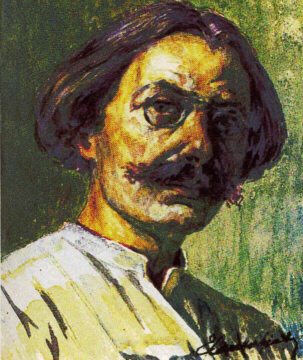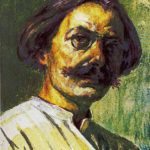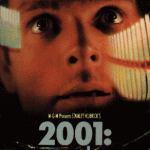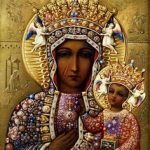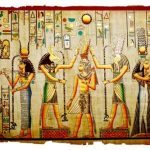PART ONE: The Theoretical Tree
by Tim Sloan and Daniel Roads
You, who are thirsty, come hither:
if, by chance, the fountain fails,
The Goddess has, by degrees,
prepared the everlasting waters
Translation by Fulcanelli of an inscription on Maitre Pierre, the grey stone of the Parvis-de-Notre-Dame, which stood in front of the cathedral until its removal in 1748.
CHAPTER ONE: Fulcanelli’s Milieu; Hermeticism, Surrealism and the Lost Generation
The Apocalypse and the Lost Generation
From our late nineties, cosmic end-of-cycle perspective, World War I, “The Great War” to those who lived through it, feels as ancient as all those other senseless wars in history. Our only connections with that conflict are faded sepia-toned images of our ancestors killing each other for reasons vaguely understood even to themselves. Demoted by an even greater war, one so large that nothing but the title World War could possibly encompass it, The Great War became a mere fancy-dress prelude to a century of destruction and horror. Reading of the ideals and passions of that long forgotten era seems embarrassing to us now. If we think of it at all, we assign it an emotional value somewhere between a massive industrial accident and the migration of lemmings to the sea.
When we look back through history, we find many wars and disasters, plagues and conquests, volcanic eruptions, climatic changes and mass migrations but we find nothing quite like the Great War. Four hundred years of European intellectual, moral and technical superiority created and fed the engines of industrialized murder. These forces in turn consumed the very social order which had created them. After four years, the self-proclaimed masters of the universe lay broken and bleeding in the wasteland, saved from ultimate extinction only by the interference of the United States and its revolutionary democracy.
Cultural suicide, perhaps? An apocalypse by any other name is still an eschatological event; it’s the end of the world for the inhabitants of that world. For example, near the end of the Great War, in September of 1918, the Turkish 12th Army, holding the ridge line in front of Damascus, which included the ancient mound of Meddigo, was attacked and destroyed by the combined use of airplanes, tanks and cavalry. This battle, eerily described in the Book of Revelation, Chapter 16, suggests that Armageddon occurred in 1918.
Not only is the battle clearly delineated but it occurred in the midst of the worst plague since the Black Death of the 14th century. The Book of Revelation’s apocalypse looks much like the history of the 20th century, leading up to one final millennarial explosion. Could this be true? Was the prophecy of Revelation an ongoing process that essentially started sometime before the Great War? Was the 20th century an unfolding of the final book of the Bible?
When the Great War finally ended, on the 11th hour of the 11th day of the 11th month, the old world, with its noble and imperial ways, was well and truly dead. The “victorious” allies propped up the corpse of Europe and, using all the tricks of the undertaker’s trade, gave it the brief appearance of animation. This lasted just long enough to necromancy a treaty together at Versailles. It decomposed soon enough, its stench conditioning Europe for the burned bacon aroma of the Nazi ovens. But while it lasted, this zombie summer of fast fading European superiority galvanized the world.
The epicenter of this fleeting renaissance was Paris, the City of Light. During the war this city had been the goal for which millions of men had marched, fought, bled and died. As it had for centuries, Paris became a symbol, to both sides in the conflict, of something irrepressible in the human character. After the war, it became a Mecca for all those who felt that the world must be changed somehow by the horror and sacrifice of the war. And that this change must mean something, say something and do something. They came to Paris like insects drawn to the light of immolated cultures, having burned their candles all at once in the final Auto de Fe of European civilization. They firmly believed that out of that conflagration would come a better world.
And so they came to Paris to help create that world: mystics, visionaries, painters, poets, artists of all kind, scientists, political thinkers, revolutionaries, all looking for that new world of hope, peace and freedom which, they felt, must grow out of “the war to end all wars.” The conflict had made them all equal now. They mingled on the boulevards, drank and talked at the cafes and bars and bookstalls, plotted and painted late into the night in small cold-water flats in the Montmartre or danced and drank in the nightclubs and demi-monde dives of the Latin Quarter. As if driven by deep rooted survival guilt, everyone wanted to live fast, fully and gloriously. Paris, in the post-apocalyptic Twenties, was the light of the world, the flashpoint of history. And the beginning of the end of time itself.
Out of this all too brief efflorescence emerged artistic, literary, social, political and scientific concepts that shaped much of the rest of the century. From the Surrealists, such as Hans Arp and Marcel Duchamp, to the mathematics of Paul Dirac, to the literary pyrotechnics of James Joyce, the idea of “transformation” bubbled just below the surface. It was at the zenith of this transformative undercurrent that, in 1926, an anonymous volume – issued in a luxury edition of 300 copies by a small Paris publishing firm known mostly for artistic reprints – rocked the Parisian occult underworld. It’s title was The Mystery of the Cathedrals. The author, “Fulcanelli,” claimed that the great secret of Alchemy, the queen of western occult science, was plainly displayed on the walls of Paris’ own cathedral, Notre-Dame de Paris.
In 1926, Alchemy, by our post-modern lights a quaint and discredited renaissance pseudo-science, was in the process of being reclaimed and reconditioned by two of the most influential movements of the century. Surrealism and psychiatry stumbled onto Alchemy at about the same time, and each attached their own notions about reality to the ancient concept. Carl Jung spent the Twenties teasing out a theory of the archetypal unconscious from the symbolic tapestry of alchemical images and studying how these symbols are expressed in the dream state. The poet-philosopher Andre Breton and the Surrealists made an intuitive leap of faith and proclaimed that the alchemical process could be expressed artistically. Breton, in his 1924 Surrealist manifesto, announced that Surrealism was nothing but alchemical art.
Fulcanelli’s book would have an indirect effect on both of these intellectual movements. Indirect, because the book managed a major literary miracle. It became influential while remaining, apparently, completely unknown outside of French occult and alchemical circles. This is perhaps the strangest of all the mysteries surrounding The Mystery of the Cathedrals.
One illustration suffices to show the magnitude of the occlusion. Take any art history text on the gothic cathedrals written in the last thirty years and look at what it says about the obscure images found on the walls and entrance ways of Notre-Dame. You will find, four times out of five, that alchemy is mentioned as a possible meaning for these vaguely Christian images. You will also find, especially if the text book is in English, that Fulcanelli and The Mystery of the Cathedrals are not given as a source, or mentioned in any way.
A popular TV special on Alchemy, hosted by Leonard Nimoy, uses the very same images from Notre-Dame that Fulcanelli presents, describes them in direct Fulcanelli paraphrase, and never mentions its source. It’s as if the concept entered common usage without ever being individually articulated.
We may call this The-Dog-That-Didn’t-Bark-In-The-Night effect. Like the dog that doesn’t make a sound while the house is robbed, Fulcanelli’s work is conspicuous by its absence. On the other hand the book’s wide-spread influence suggests an importance far beyond the antiquarian idea that the cathedrals were designed as alchemical texts. To understand the silence, we must first understand Fulcanelli.
Fulcanelli, Surrealism and the Secret of Alchemy
Early in 1926, publisher Jean Schemit received a visit from a small man dressed as a pre-war Bohemian, with a long Asterix the Gaul style mustache. The man wanted to talk about Gothic architecture, the “green argot” of its sculptural symbols and how slang was a kind of punning code, which he called the “Language of the Birds.” A few weeks later, Mr. Schemit was introduced to him again as Julien Champagne, the illustrator of a proposed book by a mysterious alchemist called Fulcanelli. Mr. Schemit thought that all three, the visitor, the author and the illustrator, were the same man. Perhaps they were.
This is our most credible Fulcanelli sighting. Beyond this, he exists as words on a page and, in some occult circles, as a mythic alchemical immortal with the status, or identity, of a St. Germain. There were two things that everyone agreed upon concerning Fulcanelli. One, he was definitely a mind to be reckoned with and two, he was a true enigma.
What seems to have happened is that Fulcanelli’s student, a young occult upstart named Eugene Canseliet, offered the publisher the manuscript of The Mystery of the Cathedrals. Schemit bought it and Canseliet wrote a preface for the book in which he stated that the author, his “master” Fulcanelli, had departed this realm. He then goes on to thank Julien Champagne, the man whom Schemit thought was Fulcanelli, for the illustrations.
Champagne, a minor Symbolist artist far into an absinthe fueled decline, had gathered around him a small entourage including Canseliet. The talk centered around alchemy when they met in the small cafes of the Montmartre. Champagne lived nearby, in the rue de Rochechouart, and his sixth floor room in the crumbling Parisian tenement was often the scene of late night symposiums on all sorts of occult subjects. To his young friends, he must have seemed like a ghost from another age, with his unfashionably long hair, his riddles, and most of all, his claim to know the secrets of alchemy.
At the time, no one else but Schemit seemed to believe that Julien Champagne was Canseliet’s master, Fulcanelli. His taste for great quantities of Pernod and absinthe indictated a man too dissipated to be as knowledgeable and erudite as the author of Cathedrals. However, he certainly did know a real alchemist, whoever Fulcanelli was, and his illustrations show that he indeed had a profound understanding of the alchemical art.
So we are left with the unsolveable mystery of the missing master alchemist. A man who does not seem to exist, and yet is recreated constantly in the imagination of every seeker. A perfect foil for projection. We might even think it was all a joke, some kind of elaborate hoax, except for the material itself. When one turns to Mystery of the Cathedrals, one finds a witty intelligence who seems quite sure of the nature and importance of his information. This “Fulcanelli” knows something and is trying to communicate his knowledge, of this there can be no doubt.
Fulcanelli’s main point, the key to unraveling the mystery, lies in an understanding of what he calls the “phonetic law” of the “spoken cabala,” or the “Language of the Birds.” This punning, multi-lingual word play can be used to reveal unusual and, according to Fulcanelli, meaningful associations between ideas. “What unsuspected marvels we should find, if we knew how to dissect words, to strip them of their barks and liberate the spirit, the divine light, which is within,” Fulcanelli writes. He claims that in our day this is the natural language of the outsiders, the outlaws and heretics at the fringes of society.
It was also the “green language” of the Freemasons (“All the Initiates expressed themselves in cant,” Fulcanelli reminds us) who built the art gothique of the cathedrals. Ultimately the “art cot,” or the “art of light,” is derived from the Language of the Birds, which seems to be a sort of Ur-language taught by both Jesus and the ancients. It is also related to the Sufi text by Attar the Chemist, entitled “The Conference of the Birds.” In de Tassey’s French translation of this work, which Fulcanelli references, the “conference” of the title is translated as “language.” De Tassey goes on to explain the complex linguist metaphor beneath the simple fable. Fulcanelli uses the same method to decode the alchemical meaning of the cathedrals.
Fulcanelli also claims that Rabelais’ Gargantua and Pantagruel is “a novel in cant,” that is, written in the secret language. Offhandedly, he throws in Tiresias, the Greek seer who revealed to mortals the secrets of Olympus. Tiresias was taught the language of the birds by Athena, the goddess of wisdom. Just as casually, Fulcanelli mentions the similarity between gothic and goetic, suggesting that gothic art is a magic art.
From this, we see that Fulcanelli’s attempt to impress upon the reader the fact that there is a secret in the cathedrals, and that this secret was placed there by a group of initiates — of which Fulcanelli is obviously one — depends upon the abundance of imagery and association which overpowers the intellect, lulling one into an intuitve state of acceptance. Fulcanelli, like Shakespeare, overwhelms the reader with his brilliance. It is difficult to accept this man as anything but an incredible intelligence.
But even after careful reading, one finds that the “mystery” of the cathedrals is never explained, and that what one assumes to be the basic mystery of Alchemy is only glancingly delineated. There are allusions that escape the reader as easily as a mosquito glimpsed out of the corner of your eye. At moments, a glimpse of a great truth flits by, giving a hint of something incredible, and then, like the mosquito, it is gone. Cathedrals feels more like a Haiku poem, one that is ephemeral and fleeting. Frustrated, the reader starts over, reading even more carefully, following the allusions and associations, trying to find and pin down the core of meaning that one senses is there, somewhere.
All this makes Cathedrals an almost perfect Surrealist text, a modern alchemical version of Lautreamont’s Chants of Maladoror, the Surrealists’ favorite 19th century novel. Fulcanelli’s use of punning word play to convey spiritual meaning would have delighted the Surrealists. They also embraced Rabelais and understood this kind of linguistic alchemy in terms of the correspondences and connections between objects or ideas on different levels or scales of being. The classic example of this being Lautreamont’s “sudden juxtaposition on a dissecting table of a sewing machine and an umbrella.”
And yet, even though Fulcanelli’s basic idea — an operational and linguistic alchemy used by sages or Hermetic Philosophers to transform reality — became part of Surrealism’s intellectual currency, none of the Surrealists mention Fulcanelli or Mystery of the Cathedrals. Only Max Ernst makes any allusion to it, in Beyond Painting, published in 1936. However, by the late 1940’s, the work of the movement’s founder, Andre Breton — in both his book, Arcana 17 and the catalogue for the 1947 Surrealist Exhibition — appears to be heavily influenced by Fulcanelli.
Surrealism in 1947, the Surrealist exhibition catalogue, is full of seemingly Fulcanelli inspired articles such as “Liberty of Language” by Arpad Mezei. In this article he explains the “occult dialectic through linguistics.” Mezei goes on to announce that language is “really an ensemble of symbols. And this conception of language is not far off that which existed in magical civilizations, because the interchangeability of reality and language. . .is the base and the principal key of all hermetic activity.”
As if to make the point even more pointed, Arpad Mezei and Marcel Jean contributed an article on the occult meaning of the surrealists’ favorite novel The Chants of Maldoror. Their analysis of this novel could be applied just as fruitfully to Mystery of the Cathedrals. Indeed, as we will see a little later, following Mezei and Jean’s advice by working backwards is a good roadmap for navigating Fulcanelli.
Andre Breton himself contributed a chart to the catalogue for Surrealism in 1947 showing personalities and their associations with the images of the Tarot cards, a continuation of the ideas that he had begun in Arcana 17. While the Tarot is not an obvious connection with Fulcanelli and the Mystery of the Cathedrals., as we will see, Breton’s use of the Tarot as alchemical images suggests that he had read Fulcanelli even closer than most. Ten years later, in 1957, Breton wrote The Art of Magic , in which he insists that magic is an innate capacity of all humanity which can never be long suppressed or controlled. And with that admission, Surrealism takes its place alongside the literary works of Joyce, Lovecraft and Bourges as an important 20th century artistic addition to the western occult tradition.
It would seem that Fulcanelli contributed to that artistic evolution, except the conspicuous absence of direct reference argues against it. Fulcanelli’s ideas seem to be present in Surrealism from its inception, growing more prominent as the movement matured. Possibly one answer lies in the anonymity of Fulcanelli himself. Since “Fulcanelli” is a pseudonym, the Surrealists may have absorbed his ideas from a common source, the real person behind the name.
Yet, even that idea fails to explain the curious reluctance of anyone, Surrealist, art historian and alchemical scholar alike, to address the meaning of Fulcanelli’s work. Once again, this conspicuous absence is very suggestive. Even the great American occult historian Manley P. Hall completely fails to mention Fulcanelli. Many scholarly books written since the 1930’s about alchemy and it’s history fail to mention the two known books by Fulcanelli. Why?
The silence suggests a secret. The “mystery” of the cathedrals is the secret of alchemy in the sense that alchemy is an ancient initiatory science. “Fulcanelli” selected his materials carefully to convey in the clearest and most direct manner possible that he did indeed know the secret. Much has been made by the few occultists who have looked into Fulcanelli and his work about the difficulty of his writing. Threading a path through Fulcanelli’s mine field of classical allusions is daunting to all but those who enjoy sampling ancient wisdom for its own sake. Without a key, the text remains, reading after reading, incomprehensible.
However, as in the Sufi story, the greatest treasure is hidden in plain sight. Fulcanelli slyly directs us with his comment on goetic or magic art. The magic, the secret, is in the art.
More Articles from Sangraal.com:
Submit your review | |

